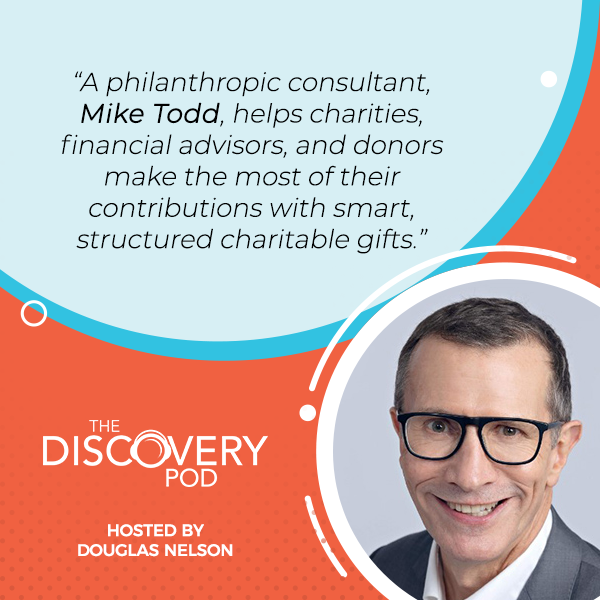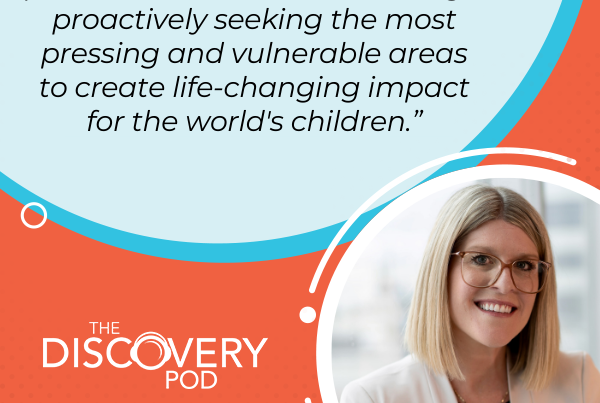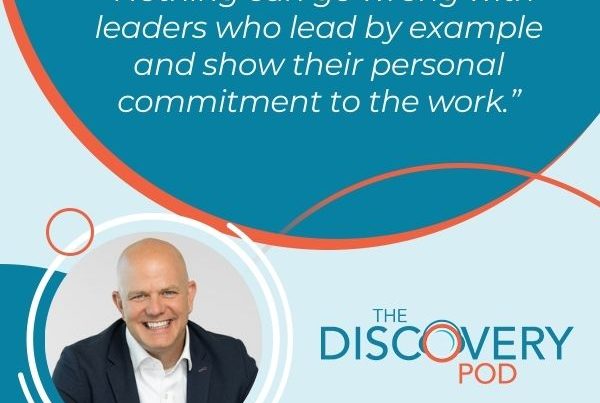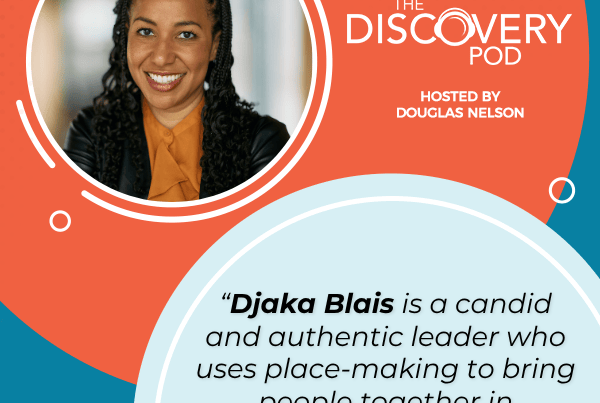
Donor-advised funds (DAFs) are changing the landscape of charitable giving. DAFs are a revolutionary tool that puts you, the donor, in control. In today’s informative episode, Mike Todd, the founder of Transform Philanthropy, explores the benefits of DAFs for donors and charities, dispels common myths, and provides actionable strategies to maximize your impact. By educating donors about DAFs and using the term strategically, charities can position themselves to receive more charitable contributions. Mike also explains how strategic philanthropy helps maximize your charitable donations. Learn how to cultivate relationships with DAF sponsors and unlock a new revenue stream for your organization. Join Mike Todd and learn to harness the power of donor-advised funds.
—
Listen to the podcast here
Transform Philanthropy With Mike Todd, Founder
My guest is Mike Todd. Mike is the Founder of Transform Philanthropy. In our conversation, we talked about everything you wanted to know and probably some things you felt like you didn’t need to know about Donor-Advised Funds, or DAFs as we call them, and they’re called across the sector. One of the questions I’m asked often by CEOs, members of boards, and heads of fundraising as we go through our work here at the Discovery Group is, “What are other people doing to manage DAFs? How are they thinking about them? How can we maximize them? How can we build relationships with the fund sponsors?”
I thought when I met Mike, we should have this conversation, put it out to our readers and sector. The expertise is someone who has thought a lot about it, who is a big fan of DAFs, to share what he knows and give advice to organizations, boards, and individual fundraisers about creating a new alternative revenue stream or a new revenue stream in general within your organization.” If you’re curious about donor-advised funds and the role that they can play and do play every day in our sector, you’re going to love this conversation with Mike Todd of Transform Philanthropy.
—
Welcome to the show, Mike.
I’m happy to be here. Thanks.
It is great to have you on. Normally, I ask our guest to talk about their organization first and we’ll get there, but I want to jump to my big question. What is a Donor-Advised Fund and why is it causing havoc in our social profit sector?
Donor-Advised Fund
Right to the heart of the matter, I like it. A Donor-Advised Fund, in my view, is very simply a giving vehicle that allows a donor to reap the tax benefits today, and then make, recommendations on grants to charities tomorrow, the next day, or the next year in the future. That’s all it is. The major question though is, “Why is it wreaking havoc?” It’s interesting. I like to refer to the Donor-Advised Fund, and I’ll probably say DAF 100 times during this interview. That’s what I mean.
It’s 70 years old in Canada, but for 60 of those years, it was the secret of the community foundation world. Most people don’t know what it is or are not that familiar with it. I like to refer to it as the oldest due product out there. it’s wreaking havoc because it’s “new.” There have been some cases where charities were expecting a direct donation and it ended up going into a Donor-Advised Fund instead. That has the appearance of being a competitor when it should be an ally. To repeat myself, it’s a giving vehicle that people can use to strategically plan their giving as opposed to just writing a check to a charity.
You introduced that saying the oldest new product on the market. I like that. It’s been 60 years available through community foundations now for the last many years, more available through commercial providers. How has it changed the giving landscape and what do you see as the opportunities for social profit organizations in this changing landscape?
The way it’s changed the landscape is a couple of reasons. It now involves a donor’s professional advisors, be they an accountant or an investment advisor, a lawyer, etc. There’s an opportunity to include your professional team in your giving. That’s a bit of a game-changer right there. It’s an opportunity to make sure that your giving is being done in the best or optimal way from a financial standpoint. I think sometimes when I say that, it doesn’t happen as much as it used to, but I offend a few people because I think, “Giving should be from the heart, not necessarily a financial transaction.”
I agree with that, but if I’m going to get from my heart, I want to use my head and do it as well and as effectively and efficiently as I can. I have no problems making sure that my account knows what I’m doing, making sure that my advisor is involved in choosing the securities that I’m going to donate, etc. It’s a new thing. I think some fundraisers look at it as a bit of a competitor. My calling is to try and straighten out that thinking.
The idea that it is something that needs to be overcome or subverted from the part of fundraisers or organizations is problematic. It’s not like individuals have a challenge or a problem with annual giving or monthly giving or even state giving as a way for donors to benefit the community, but somehow DAFs have this reputation. For organizations that are able to shift their mindset and see it as a new revenue stream or as the oldest new revenue stream available to them, how can they get started?
First, pick a number, 5 or 10 donor-advised fund grants could come from donors who are already in their database. I think the opportunity is first to figure out who already has one and hasn’t necessarily been getting from it, and then to go from there. Beyond that, you need to understand it and see the benefits of partnering with it. I like to say that it’s not an adversary, it should be an ally. That involves a pretty good knowledge of how it works. Dig deep into your own database first, find out who has them and if you want, interview them, ask them how it’s been going, “Do you get from it often? Do you always get from it? How do you feel about it?” Start from there.
It's crucial to truly understand DAFs and see the benefits of partnering with them. Share on XWhat mistakes have you seen organizations make when they’re trying to work with a donor-advised fund?
It’s almost the inverse of your question. The biggest mistake is not to try to work with the donor-advised fund. Most often what I see is a charity will receive a check or an EFT from a Donor-Advised Fund and XYZ foundation. They don’t know who that is or they may have a faint idea, but they don’t really understand that there may be an actual individual donor behind it. Often that check gets cashed and that’s the end of the line for that donation. There’s no opportunity to try and figure out who the donor is and to steward them appropriately.
It is an alternative form of payment. That’s all it is from the charity’s perspective. It’s a number of things for the donor, but from the charity’s perspective, it’s an alternative form of payment. It’s still somebody behind that making a grant and wanting to support your organization. The challenge is to figure out who that is and to steward them as if they’d written you a check. Some donor-advised funds have been better at revealing who the donor is than others. We’re all working on this and trying to get more efficient and develop best practices.
Presumably, some donors want to be anonymous and that’s why they’re using a Donor-Advised Fund.
Some do. It’s funny, when you look at these numbers in Canada and the US, they’re almost identical. It’s less than 5% intend to be anonymous. I use the word intend on purpose because sometimes they end up being anonymous without intention. That’s what we’re trying to work to overcome, but most of them are not. To dive deep for one second, when I work with charities, I say to them, listen, “When you get a DAF brand, automatically assume it’s not supposed to be anonymous because 95% of the time, that’s correct. If you can’t find a name, then pick up the phone and call the donor-advised fund sponsor and say, “Thanks for this. I got this. Who’s the donor?” Please assume that the donor wants to be known and go from there. You’re going to be right most of the time. that’s the number one tactic I find helpful.
A direct line. Pick up the phone. In fundraising, contacting the person directly, do you think that might work?
Nobody uses the phone anymore, but it’s helpful. it’s important as a development person that you develop relationships with the top two or three donor-advised funds that you keep seeing checks from. Know who to call and what their number is and try to develop a bit of a relationship there.

Transform Philanthropy: It’s important to build relationships with the top two or three donor-advised funds (DAFs) you consistently receive checks from.
That’s a good advice. One of the ways I think we can help dispel the myth around Donor-Advised Funds being an adversary, being a challenge to fundraising in our sector is for fundraisers to sit in the seat of the donor and think through why a donor might choose a Donor-Advised Funds, why a DAF is appealing to them. What has been your experience with why donors choose to give through a DAF rather than directly to the organizations they want to support?
I go back to my earlier comment about the two transactions and involving my professional advisor. What I see is that Donor-Advised Funds allow a donor to get in front of their giving. We’ve used terms in the past checkbook charity and very reactionary giving. What I want to do is, as I said earlier, make sure that I’m doing it as efficiently and effectively as I can. Often what that means is I’m going to fund my donor advice fund, let’s put it that way. I put money into my DAF, not when somebody’s asked me for money, but when I have it, when the stock market’s been doing well and I’ve got some capital gains when I’ve sold my business, some liquidity event where I need a tax receipt, that’s when I put money into the DAF. Separate from that, I sit down and decide what to do with this pool of money that I now have and who to give that to. Skip to the end, the best line of the story is that’s the opportunity.
I’m creating a pool of money that can only go one direction and that’s to a charity. The opportunity for our nonprofits is to realize that don’t worry about when I’m putting money into my debt. In fact, if you think about it, you probably want to encourage that because you’re making my pool bigger and you’re making sure that I’m involving my accountants or my advisors, and now I’ve got this pool and it can only go one way.
I like to say to fundraisers that I think you’ve got two problems you’re trying to overcome. You’re trying to convince me to give away some of my money, and you’re trying to convince me that that money should go to you and your organization. If I’m funding my DAF, I’ve already taken care of problem number one and now it’s a question of developing that relationship with me as a donor and giving me reasons why I want to partner with you. The transactions and that’s another word that people raise their eyebrows at me sometimes. The two separate transactions, you see them very clearly and very separate, it starts to make a little more sense. As a donor, it’s a fantastic tool. For the charity, it’s a different form of payment.
One of the mistakes I’ve seen some fundraisers or organizations make and how they orient themselves to donor-advised funds is they want to cultivate the fund sponsors. They want to come in for a tour, come in, and understand us and the fund sponsors as the surrogates for the donors. Some sponsors and professionals are open to that and will participate. Most will not. What advice would you have for an organization that’s been trying to do what they do with family foundations or individual donors, they’re trying to replicate those activities for DAF sponsors and it’s not working?
Most donor-advised funds that I know of would consider themselves cause agnostic. They work for the donor and they are successful when they manage to, link the donor with their favorite charities. The Donor-Advised Funds is not going to make recommendations, they’re not going to have a favorites list and it’s pointless to treat them as a family foundation where you can cultivate that relationship. In fact, they’ll be resistant to that. You do want a relationship, but that’s more of an administrative one where you need somebody who you can ask questions of, but they’re not going to move you to the top of their list. To understand that and in this circumstance, always keep in mind that behind that DAF grant is an individual and that’s the goal, is to understand who that person is and then to steward them as you would with anybody else. The DAFs are going to be a little standoffish if they think that you’re trying to get the most favored nation status with them.
Rather than seeking that donor and recipient relationship, what you say is building a relationship based on one trusted advisor talking to another trusted advisor, that this is about two professionals having a conversation about encouraging and facilitating a transaction on behalf of the donor that’s behind the fund. Is that fair to say?

Transform Philanthropy: Build a relationship based on one trusted advisor talking to another trusted advisor. That is about two professionals conversing about encouraging and facilitating a transaction on behalf of the donor.
That’s a beautiful way to put it. The Donor-Advised Funds will consider themselves successful when they’ve matched a donor with a cause that’s important to them. In that sense, everybody’s on the same page. They want to achieve good charitable giving.
It’s remarkable to me, the number of times I’ve heard from CEOs, and their boards are asking them about donor advice funds and how they’re managing these donor advice funds. What advice would you have for a CEO who may be half a step removed from the direct day-to-day fundraising of the organization? They’re in CEO land, they’re getting questions from their board about donor-advised funds. How do they get started? How should they approach answering those questions from their volunteer board of directors?
The important thing to keep in mind here is a phrase that I’ve grown to love and that is it’s an alternative revenue stream. That’s a term that may get a board excited because we all know what situations are these days. Giving is down, costs are up and demand for services is up, but if you can cultivate an alternative revenue stream, that’s something that’s going to catch people’s attention. The CEO behooves them to understand the DAF as a source of funds, but then to position it with the board as exactly that. It’s not a competitor, first of all. It’s not an alternative, it’s simply an alternative revenue stream. That’s the term that I’m using now when I speak to senior leadership board to boards. That seems to get their attention.
A lot of alternative revenue is starting a social enterprise or consolidating the back office services and providing it to other social profits. It’s complicated. It’s not available to most style strategies, but DAFs are available to all charities. Let me convert that. How big does a charity have to be to have a DAF strategy?
You need to have a registration with the CRA and maybe one person to make those phone calls, but it’s simple. I think everybody should do it. There’s almost a bit of a barbell because people say, “I guess you’re working with the largest charities.” I do, but I’ve also worked with a one-person charity that was able to make a slight adjustment to their internal processes, marketing, and website, and boom, now they appear DAF savvy, DAF literate, and DAF friendly. You’ve reset the table. Now you’re going to be able to reap some of the benefits of that regardless of the size of the organization.
What are the characteristics of being DAF literate?
DAF literate is having the words Donor-Advised Fund appear somewhere on your website or marketing material. I can recall two distinct conversations with donors who had DAFs. I was speaking with them about it and how much they enjoyed it, and they were raving about it. In both cases, they said to me, “Yeah, but I still have to write a check to charity ABC.” I thought, “That’s odd. Why are you doing that? You have a Donor-Advised Fund and you seem to understand what it is.” “I know I love it, but I don’t think they take DAF money.” I said, “Why would you say that?”
“No one’s ever asked me if I have one. No one’s ever used the word, I don’t see it in the annual report. I don’t see it on the website. I don’t see it on the collateral material. I assume they don’t take it. Take money from donor-advised funds.” That’s happened to me twice with two different people. You could say they didn’t ask, but I don’t think the owner should be on the donor. The owner should be on the charity to say, “We take credit cards, checks and Donor-Advised Funds because that’s an alternative form of payment. “
I remember very clearly early in my career, but it wasn’t super early in my career when the tax treatment for gifts of appreciated securities came online. All of our proposals at that time had a sheet in them that said, “We’re not financial advisors. Please check with your financial advisor, but here are the tax benefits. If you’re in the highest tax income bracket, here’s what the advantage of it is.” We did a lot of both indirect and direct promotion of this as a vehicle for giving. We wanted to seem savvy that we understood this and this was something of value we were offering to our donors.
2 or 3 years into that new tax regime, all the donors knew about it. We didn’t need to put it in front of them as much. We didn’t need to show the models of the financial benefit of giving appreciated securities because they knew. Is it time for charities to be that out front and explain, “If you have a DAF, this is how your donation’s treated, or we’re open to it, we’ll take DAF money?” How can they make it easy or obvious for donors to step forward and give that way?
It’s past time. The words Donor-Advised fund should appear wherever you would be mentioning other forms of gifting and don’t be afraid of it. Every single donor conversation your fundraisers have, ask them, “Do you happen to have a donor-advised fund?” I promise you, 9e times out of 10 they’re going to get a quizzical look. the donor’s going to say, “I don’t know what that is.” That’s fine. 1 time out of 10 you’ll get a yes and that’s going to go somewhere. 9 times out of 10, you have an opportunity now to explain to the donor, “Maybe you want to have your own branded little piece of collateral that talks about Donor-Advice Funds.” Explain to them how it could be beneficial for them to give through Donor-Advice Funds.
The more progressive charities that I’m speaking to now who finally say, “I get it. We should be all over this. I understand that. Can you come in and speak to some of our donors?” There are some charities out there that proactively educate their donors about the benefits of using a DAF. That’s gutsy in a sense because there are still others who aren’t there yet. But I think that’s fantastic because we all know that Charity A is not getting all the money, but what if Charity A is the one who said to the donor, “We’ve appreciated your support over the last twenty years. We know you’re now having an opportunity to give more. Can we sit down and talk to you a little bit about a vehicle that may be a little more effective for you to use in your giving?” If I’m giving to 3 charities and 1 of them finally comes to me and says, “There’s a better way to do this, that charity raised their head above the crowd a little bit.”
Strategic Philanthropy
In our conversation and in our travels where we’ve talked before, you use the term strategic philanthropy quite a bit. Can you explain what you mean by strategic philanthropy?
I love the term. I think strategic philanthropy as opposed to checkbook charity is the phrase I like to use a lot. It’s not just a question of the timing, remember my explanation of the two different transactions, but strategic philanthropy allows me to think through what I want to do and be able to make a decision about what I want to do when an opportunity arises. If I already have a donor-advised fund that I funded, then that pool is sitting there ready and waiting.
Strategic philanthropy allows us to think through what we want to do and decide what we want to do when an opportunity arises. Share on XWhen I encounter a cause or an opportunity to give, I want to be able to react and not write a check because it was more efficient for me to give those appreciated securities, which I happened to have given six months ago, but now I’m ready to make a grant out of that. Strategic philanthropy to me is getting in front of the giving and being able to react in the best way, the most efficient way, and not being under the gun and having to write a check when there would’ve been a better opportunity to do it a little bit differently.
Your enthusiasm for this comes right through the screen that our readers use to read the conversation, a bit of a street corner preacher about Donor-Advice Funds. I want to pivot the conversation a little bit to you. How did you come to be the street corner preacher?
I almost feel like I need to apologize. I get passionate about this.
No.
I could talk about this all day, hopefully, somebody’s got their finger on the stop button at some point.
Don’t apologize. Proselytize. Tell us how you came to this place.
I’ll give you the thumbnail sketch. I spent the first dozen years of my career in the wealth management world. Most of that was in Toronto. I spent ten years with Fidelity Investments, mostly on the sales side, interacting with the financial advisors. That’s why I love that space so much and why I understand that world. I speak the language of advisors. I worked my way up the chain a little bit at Fidelity, and I got to a stage where I was making more money than I thought anybody should. I sat back and thought, “Is this going to be the rest of my life?” I came to the conclusion, “That did not appeal to me. That’s not what I wanted my life to be.” I left, I negotiated an exit, as they say, and I went and joined World Vision in Mississauga.
I ended up doing that for one year. It was a great experience because it was a transition from Bay Street to the charity world. I did corporate development. I was still wearing a suit. I was still comfortable in a boardroom, but that was a transition. I moved out here to Vancouver and spent 9 years working for a tiny little 3-person volunteer-based charity working in the Downtown East side with marginalized women. I tell people it’s true. I put my suits away. I grew my hair alone. I had a beard. I carried a protest sign for a while and figured Bay Street days were over. I did that for nine years. I ended up living in China for two years because I wanted to go and see it. That’s a strange thing to say, but it’s true.
I came back to Canada after two years. This was in the beginning of 2014. I thought, “All my suits are out of date. They got cuffs on them. I can’t wear those anymore. I guess I’ll go work for a charity.” I stumbled across a role at the Raymond James Canada Foundation. They were looking for an ED. I took that role and I discovered what a donor-advised fund was. I mean, to be perfectly honest, I didn’t understand what they were beforehand. I bluffed my way through five interviews at Raymond James. I got the job and didn’t figure out what it was. I fell in love with the DAF and understood the appeal to the wealth advisors in the firm and how they could better serve their clients who were charitable givers.
I went from there. I spent two years at Raymond James. I went and spent five years with Charitable Impact or CHIMP. I’m working with advisors, trying to convince more of them to incorporate philanthropy into their practice. I spent a year at Scotia, and now I’ve figured out that nobody was going to pay me to do exactly what I wanted to do. I went out on my own. I call myself a reluctant entrepreneur, but I love the product. I love the vehicle, and what it does for donors, advisors, and charities. It’s fantastic. It’s grossly not misunderstood, but not understood. That’s something that I want to change for all three of those constituents, to be honest.
I appreciate the exploration of your career. You’ve seen the sector from a lot of different angles and sides. You know it so well. You’ve been a real active participant in CAGP over a number of years. You’ve been a real champion of the sector. If you had a magic wand, what would you change about the social profit sector?
I’ll see how I can answer that with it without getting into trouble with any of those three constituents, I think the sector needs to understand that first of all, it’s we’re in the 21st century. I guess this is the way I would put it. There’s nothing wrong with professionalizing the charity space and with professionalizing the tools that we use to give and involve more professionals, wealth advisors, accountants, and lawyers. There’s nothing wrong with that because the world is in pretty rough shape and it needs help. There are tools and skill sets that to a large degree have not been involved in the social profit sector at all.
I think that needs to change. In some senses, we can be sentimental about the good old days and lament the fact that it’s becoming a little more business-like if I can use the term. I think at the end of the day, that’s a good thing because we need to be raising more money. We need to make sure that donors are feeling more attached to issues, and causes and seeking impact. At the end of the day, that’s how we’re going to achieve a lot of the goals that we all say we want to do.
We’ve come to the last question. My favorite question I ask every guest is, what are you looking forward to?
I believe I am looking forward to a time when we don’t have to spend too much energy talking about how we’re going to give, but more energy about why we want to give and the effects that that giving is going to have on the people that we want to serve. That came right out of my mouth. I hadn’t thought about that question before, but I think that’s what I want. I love what I do and I love talking about how we give, but I look forward to a day when that’s not necessary. I’ve put myself out of a job and every charity is good at receiving and optimizing grants from donor-advised funds. Every financial advisor is involved in their client’s giving, and every donor feels like they’re having an impact. That’s why I do what I do.
I think you’re going to have a job for a while. I don’t think you need to worry about being out of work. Before I let you go, please let our readers know how they can learn more about your work and Transform Philanthropy.
Reach out on LinkedIn. I spent a lot of time on LinkedIn. You can reach me at [email protected]. Clearly, I love to speak about this, no question is a bad question, and I’m happy to talk to folks about this. I honestly would not be spending my day any other way.
I appreciate you making time to be on this question about how we manage Donor-Advised Funds comes up time and again, and the work that we do here at the Discovery Group. I thought it’d be a real value to our readers to have an expert who enjoys them, talking about their advantages and giving some first steps that organizations can take. I deeply appreciate you being on the show.
Thank you so much. I enjoyed the conversation.
Important Links
- Transform Philanthropy
- LinkedIn – Mike Todd
- Mike@TransformPhilanthropy




